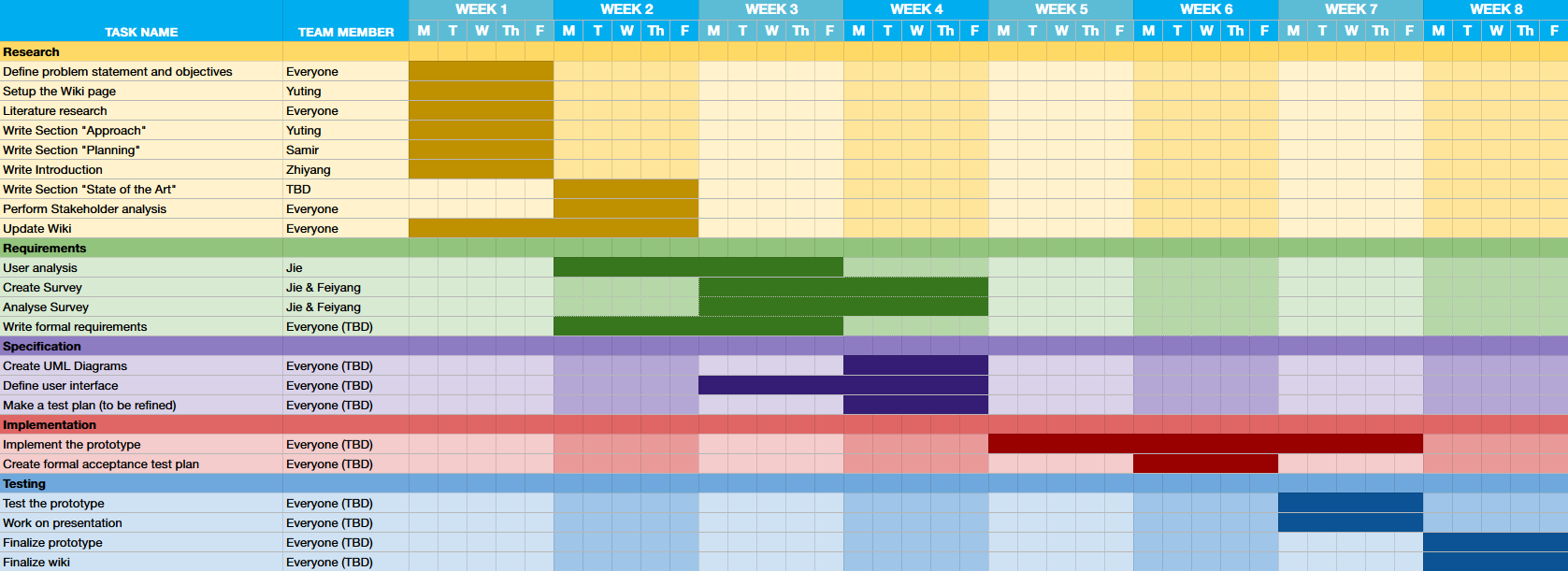PRE2023 3 Group5
Medical Robot
Group Members
| Name | Student ID | Department |
|---|---|---|
| Yuting Dong | 1546104 | Computer Science |
| Jie Liu | 1799525 | Computer Science |
| Zhiyang Zhang | 1841734 | Mechanical Engineering |
| Samir Saidi | 1548735 | Computer Science |
| Feiyang Yan | 1812076 | Computer Science |
| Nikola Mitsev | 1679759 | Computer Science |
Introduction
Problem Statement
Objectives
State-of-the-art
USE analysis
Users
Society
Enterprise
Approach
In order to reach the objectives, we split the project into 5 stages. The five stages are distributed into 8 weeks with some overlaps. Everyone in the team is responsible for some tasks in these stages.
- Research stage: In week 1 and 2, we mainly focus on the formulation of problem statements, objectives, and research. We first need to make a plan for the project. The direction of this project is fixed by defining the problem statement and objectives. Doing literature research helps us to gather information of state-of-the-art, the advantages and limitations of current solutions.
- Requirements stage: From week 2 to week 4 we will do user analysis to further determine the goal and requirements of our product. We will collect information about user needs by surveys and interviews. The surveys and interviews can contain information found in the research stage. For example, how does the user think about the current solution, what improvements can be made.
- Specification stage: This stage is in week 3 and 4, in which we create the specification of our product using techniques such as UML diagrams and drawing user interface. From the user analysis and the research, we can create the specification in more detail. After this, a test plan will be made so that the product can be tested to see whether it meets the requirements and the specification.
- Implementation stage: The prototype of our product will be implemented in this stage from week 5 to week 7. We plan to only create the digital part of the product due to time constraints. Also, a more formal test plan will be constructed for later use.
- Testing stage: In week 7 and 8, the prototype will be tested by the test plan and we can examine whether the product reaches our goal and solves the problem. The finalization on the prototype, presentation and wiki page will be done in this stage.
Planning
We created a plan for the development process of our product based off of the previously described approach. This plan is shown in the Gantt chart below:

Task Division
We subdivided the tasks amongst ourselves as follows:
| Research | Requirements | Specification | Implementation | Testing | |||||||||
|---|---|---|---|---|---|---|---|---|---|---|---|---|---|
| Task | Group member | Task | Group member | Task | Group member | Task | Group member | Task | Group member | ||||
| Define problem statement and objectives | Everyone | User Analysis | Jie | Create UML Diagrams | Everyone (TBD) | Implement the prototype | Everyone (TBD) | Test the prototype | Everyone (TBD) | ||||
| Setup the Wiki page | Yuting | Create Survey | Jie & Feiyang | Define user interface | Everyone (TBD) | Create formal acceptance test plan | Everyone (TBD) | Work on presentation | Everyone (TBD) | ||||
| Literature research | Everyone | Analyse Survey | Jie & Feiyang | Make a test plan | Everyone (TBD) | Finalize prototype | Everyone (TBD) | ||||||
| Write Section "Approach" | Yuting | Write Formal Requirements | Everyone (TBD) | Finalize wiki | Everyone (TBD) | ||||||||
| Write Section "Planning" | Samir | ||||||||||||
| Write Introduction | Zhiyang | ||||||||||||
| Write Section "State of the Art" | Samir & ... (TBD) | ||||||||||||
| Perform Stakeholder Analysis | Everyone | ||||||||||||
| Update Wiki | Everyone | ||||||||||||
Milestones
By the end of Week 1 we should have a solid plan for what we want to make, a brief inventory on the current literature, and a broad overview of the development steps required to make our product.
By the end of Week 3 we should have analysed the needs of our users and stakeholders, formalized these needs as requirements according to the MoSCoW method, and have a clear state-of-the-art.
By the end of Week 4 we should have specified the requirements as UML diagrams, blueprints, etc., created a basic user interface, and created an informal test plan.
By the end of Week 6 we should have created a formal acceptance test plan.
By the end of Week 7 we should have finished the implementation of our product's prototype.
By the end of Week 8 we should have tested the product according to the acceptance test plan, finished the presentation, finalized the prototype, and finalized our report.
Deliverables
The final product will be an Android application, representing the user interface, intended to be used alongside a physical robot which we will specify and try to (partially) implement.
The application will have two views, one for the patient/user, and one for the caretaker/doctor.
The robot will be equipped with a variety of sensors which will relay data to the application and should be capable of interacting with the user(s) and caretaker(s).
Logbook
Week 1
| Name | Total hours | Tasks |
|---|---|---|
| Yuting | ||
| Jie | ||
| Zhiyang | ||
| Samir | 5 | Introduction lecture (1), meeting (1.5), Gantt chart (1), Planning section (1.5) |
| Feiyang | ||
| Nikola |